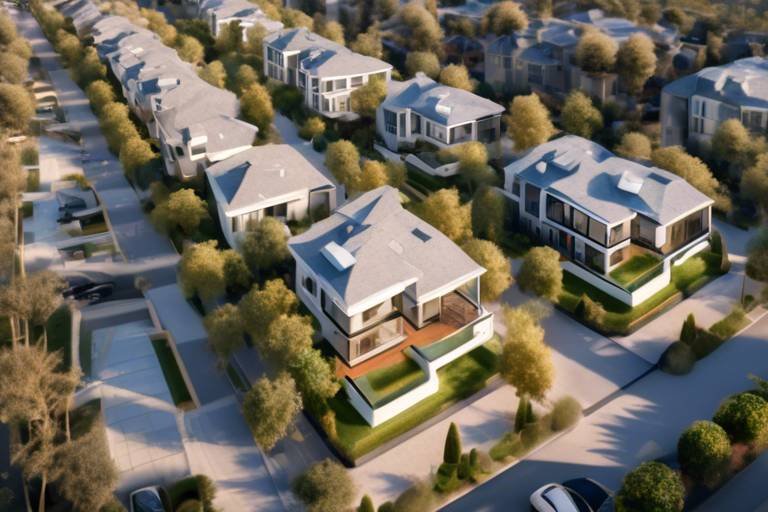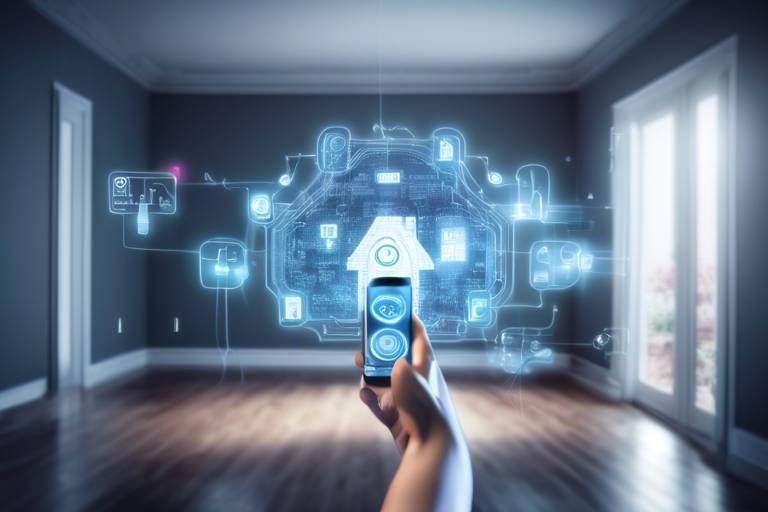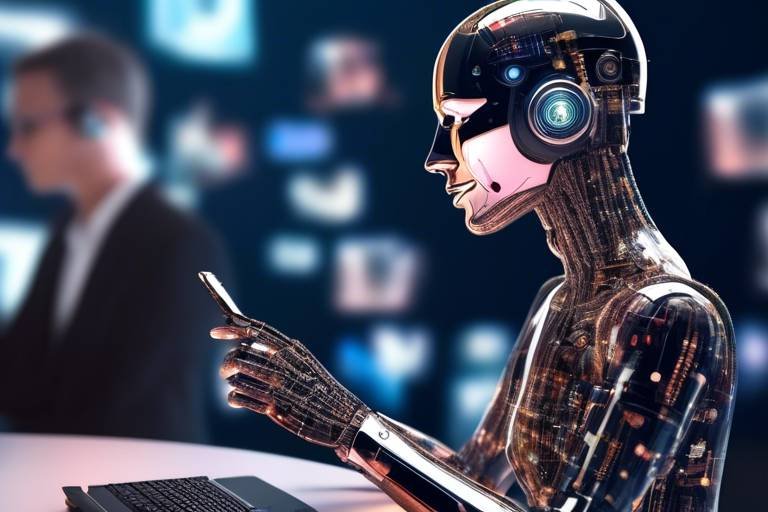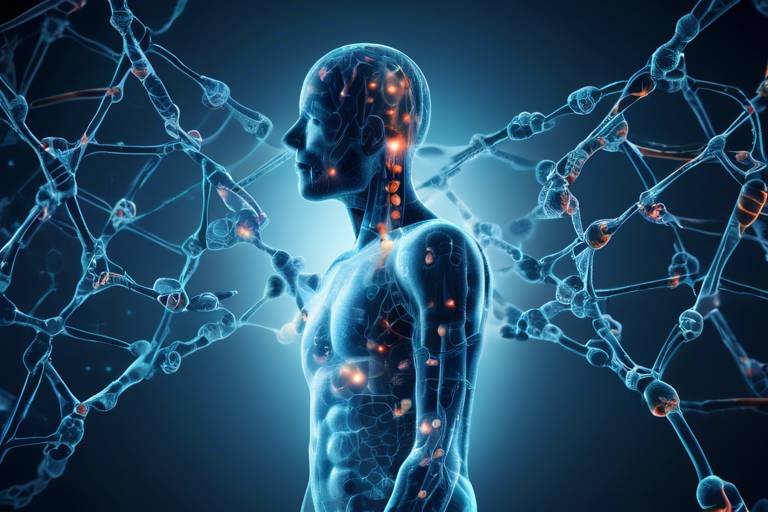Future of IoT in Smart Homes: Intelligent and Connected
The future of smart homes powered by the Internet of Things (IoT) is not just a dream; it’s becoming a reality that’s transforming our everyday lives in ways we never imagined. Imagine walking into your home, and the lights turn on automatically, the temperature adjusts to your preferred setting, and your favorite music begins to play—all without you lifting a finger! This level of convenience and intelligence is what IoT brings to our living spaces, creating a symphony of connectivity that enhances our comfort and security.
As we delve deeper into this fascinating world, it’s essential to recognize that the advancements in smart home technology are not just about convenience. They are about creating **intelligent environments** that respond to our needs, making our lives easier and more efficient. From smart appliances that optimize energy usage to security systems that keep our homes safe, the integration of IoT is reshaping the very fabric of how we interact with our homes.
Moreover, the potential of IoT in smart homes extends beyond mere automation. It opens the door to a future where our homes can learn from us, adapting to our preferences and routines. Picture a home that knows when you’re coming back from work, adjusting the lighting and temperature to create a welcoming atmosphere. This is not just futuristic thinking; it’s the direction in which IoT technology is heading.
However, as with any technological advancement, there are challenges to overcome. Issues like data privacy and device interoperability are at the forefront of discussions surrounding smart homes. Homeowners are rightfully concerned about how their personal data is used and whether their devices will work seamlessly together. Addressing these challenges will be crucial in realizing the full potential of IoT in smart homes.
Looking ahead, the integration of artificial intelligence (AI) and the rollout of 5G technology will further enhance the capabilities of smart homes. AI will enable devices to learn and adapt, creating a personalized living experience, while 5G will ensure that all devices communicate instantly and reliably. The future is bright, and as we embrace these innovations, our homes will become not just places to live, but intelligent environments that enhance our quality of life.
- What is the Internet of Things (IoT)?
The Internet of Things refers to the network of interconnected devices that can communicate and exchange data with each other, enhancing automation and efficiency in various applications, including smart homes. - How do smart homes improve energy efficiency?
Smart homes utilize IoT technology to monitor and optimize energy usage through devices like smart thermostats and lighting systems, leading to reduced energy consumption and lower utility bills. - What are the security concerns associated with smart homes?
Smart homes can be vulnerable to cyberattacks, and concerns about data privacy arise as personal information is collected and transmitted by various devices. - How will 5G technology impact smart homes?
5G technology will provide faster and more reliable connections between devices, facilitating real-time communication and control, which is essential for the seamless operation of smart homes.

Advancements in Smart Home Technology
This article explores the transformative impact of the Internet of Things (IoT) on smart homes, highlighting advancements, benefits, challenges, and the future potential of connected living environments.
Recent innovations in smart home technology have revolutionized how we interact with our living spaces. Imagine walking into your home, and the lights automatically adjust to your preferred brightness while your favorite playlist starts playing in the background. This is no longer a scene from a sci-fi movie; it's the reality brought to us by IoT. With interconnected devices and systems, homeowners can now enjoy greater efficiency, convenience, and security. From smart refrigerators that keep track of your groceries to voice-activated assistants that manage your daily schedule, the advancements in this field are truly remarkable.
One of the most significant developments is the rise of smart home hubs. These central control units allow homeowners to manage multiple devices from a single interface, simplifying the user experience. Whether it's adjusting the thermostat, locking the doors, or checking the security cameras, everything can be done seamlessly. It's like having a personal assistant dedicated solely to your home's needs!
Moreover, the integration of artificial intelligence (AI) into smart home devices is taking convenience to a whole new level. AI-powered devices learn user habits and preferences over time, adapting their functions to better suit individual lifestyles. For instance, a smart coffee maker can brew your morning cup just as you wake up, or your smart thermostat can learn your schedule and adjust the temperature accordingly, ensuring comfort while saving energy.
Another exciting advancement is the development of smart appliances. These devices are not only energy-efficient but also equipped with connectivity features that allow remote monitoring and control. For example, a smart oven can be preheated from your smartphone while you’re still at the grocery store, ensuring that dinner is ready as soon as you walk through the door. This level of control means less time spent on chores and more time enjoying life.
Additionally, advancements in home security technology have made smart homes safer than ever. With features like real-time alerts, remote monitoring, and AI-driven facial recognition, homeowners can keep an eye on their property from anywhere in the world. Imagine being able to check your security cameras while on vacation, or receiving an instant alert if someone is at your door. These features not only provide peace of mind but also deter potential intruders.
In summary, the advancements in smart home technology are paving the way for a future where our homes are not just places to live but intelligent environments that enhance our daily lives. As these technologies continue to evolve, we can expect even more innovative solutions that will redefine our interactions with our living spaces.
The integration of IoT in smart homes offers numerous benefits, including energy efficiency, enhanced security, and improved quality of life for residents through automation and remote control.
IoT-enabled energy management systems allow homeowners to monitor and optimize energy consumption, leading to significant cost savings and reduced environmental impact through smarter usage patterns.
Smart thermostats learn user preferences and adjust heating and cooling accordingly, providing comfort while minimizing energy waste, ultimately contributing to lower utility bills and a smaller carbon footprint.
IoT-connected lighting systems can be controlled remotely and programmed to adjust based on occupancy and natural light, enhancing convenience and energy efficiency in smart homes.
IoT technology significantly enhances home security through smart locks, cameras, and alarm systems that allow homeowners to monitor and control their security remotely, ensuring peace of mind.
Despite the advantages, implementing IoT in smart homes poses challenges, including security vulnerabilities, privacy concerns, and the need for interoperability among various devices and platforms.
As smart devices collect vast amounts of personal data, concerns about data privacy and how this information is stored and used become paramount for homeowners considering IoT solutions.
The lack of standardization among IoT devices can lead to interoperability issues, making it challenging for homeowners to ensure that all devices work seamlessly together within their smart home ecosystem.
The future of smart homes looks promising, with advancements in AI, machine learning, and 5G connectivity paving the way for even more intelligent and responsive home environments tailored to individual needs.
Integrating artificial intelligence into smart home systems will enhance automation, allowing devices to learn user habits and preferences, ultimately creating a more personalized living experience.
The rollout of 5G technology will enable faster and more reliable connections between devices, facilitating real-time communication and control, which is essential for the seamless operation of smart homes.
- What is IoT in smart homes? IoT refers to the network of interconnected devices that communicate with each other to enhance the functionality of a home.
- How do smart home devices improve energy efficiency? They allow for better monitoring and control of energy usage, leading to reduced waste and lower utility bills.
- Are smart homes secure? While they offer enhanced security features, they can also be vulnerable to cyber threats, making it crucial to implement strong security measures.
- What challenges do homeowners face when adopting IoT? Common challenges include data privacy concerns, interoperability issues, and the need for reliable internet connectivity.

Benefits of IoT in Smart Homes
The integration of the Internet of Things (IoT) into smart homes is like adding a touch of magic to our everyday living. Imagine a world where your home anticipates your needs, adjusts to your preferences, and enhances your lifestyle without you lifting a finger. This is not just a dream; it’s becoming a reality thanks to the myriad of benefits that IoT brings to the table. From energy efficiency to enhanced security and improved quality of life, the advantages are as exciting as they are transformative.
One of the most significant benefits of IoT in smart homes is **energy efficiency**. With smart devices, homeowners can monitor their energy consumption in real-time, allowing them to make informed decisions about their usage. For instance, smart meters can track energy usage patterns and suggest ways to reduce costs. This leads to not only **significant savings on utility bills** but also a smaller carbon footprint—a win-win for both the wallet and the planet.
Moreover, IoT-enabled energy management systems can automate the process of energy optimization. For example, smart thermostats learn your daily routines and adjust heating or cooling accordingly, ensuring that energy is not wasted when you’re not home. This level of automation means you can enjoy a comfortable environment without the guilt of overspending or overconsuming energy.
Another remarkable benefit is the **enhanced security** that IoT provides. Smart home security systems, which include smart locks, cameras, and alarm systems, allow homeowners to monitor their property remotely. Imagine being at work and receiving an alert on your smartphone that someone is at your front door. With a quick tap, you can view the live feed from your smart camera and even communicate with the visitor through a smart doorbell. This level of control offers unparalleled peace of mind.
In addition to security, IoT contributes to an improved **quality of life**. With automation, tasks that once required manual effort can now be performed with ease. For instance, smart lighting solutions can adjust based on the time of day or occupancy, ensuring your home is always well-lit without wasting energy. You can set your lights to turn on automatically as you arrive home, creating a warm and welcoming atmosphere. Likewise, smart appliances can be programmed to perform tasks at specific times, such as starting the coffee maker in the morning or preheating the oven for dinner.
To summarize, the benefits of IoT in smart homes can be categorized as follows:
- Energy Efficiency: Reduced utility bills and environmental impact.
- Enhanced Security: Remote monitoring and control of security systems.
- Improved Quality of Life: Automation of daily tasks for convenience.
As we continue to embrace this technology, it’s clear that IoT is not just about convenience; it’s about creating a **smarter, safer, and more efficient living environment**. The future of smart homes is bright, and it's exciting to think about how these advancements will continue to evolve and integrate into our lives.
- What is IoT in smart homes? IoT in smart homes refers to the interconnected devices and systems that communicate with each other to enhance efficiency, convenience, and security.
- How can IoT improve energy efficiency? IoT devices can monitor and optimize energy usage, allowing homeowners to reduce waste and save on utility bills.
- Are smart home devices secure? While smart home devices can enhance security, they also come with potential vulnerabilities. It’s essential to implement strong passwords and keep software updated.
- What are some examples of IoT devices for smart homes? Examples include smart thermostats, smart lighting systems, smart locks, and security cameras.

Energy Management Systems
Energy Management Systems (EMS) have emerged as a game-changer in the realm of smart homes, making it easier for homeowners to monitor and control their energy consumption. Imagine walking into your home and instantly being aware of how much energy each appliance is using. With IoT-enabled EMS, this scenario is not just a dream—it's a reality. These systems leverage real-time data to provide insights into energy usage patterns, enabling homeowners to make informed decisions that can lead to substantial cost savings and a reduced environmental footprint.
One of the standout features of these systems is their ability to optimize energy consumption. For instance, by analyzing usage data, an EMS can suggest when to run high-energy-consuming devices, such as dishwashers or washing machines, during off-peak hours when electricity rates are lower. This not only helps in saving money but also contributes to a more sustainable environment by reducing the demand on the grid during peak times.
Moreover, the integration of smart meters within these systems allows for real-time monitoring of energy consumption. Homeowners can access detailed reports that break down energy use by appliance, providing a clear picture of where savings can be made. The data can be visualized in various formats, such as graphs or tables, making it easier to comprehend. For example:
| Appliance | Daily Energy Consumption (kWh) | Monthly Cost ($) |
|---|---|---|
| Refrigerator | 1.5 | 45 |
| Washing Machine | 2.0 | 60 |
| Heating System | 5.0 | 150 |
| Smart TV | 0.8 | 24 |
This table provides a snapshot of how different appliances contribute to energy costs, allowing homeowners to pinpoint which devices might need a little extra attention when it comes to energy efficiency. By using this data, you can make strategic decisions about when to use certain appliances or even consider upgrading to more energy-efficient models.
In addition to cost savings, IoT-enabled EMS also plays a significant role in enhancing the overall comfort of your living environment. For example, smart thermostats can adjust heating and cooling based on real-time occupancy data and weather forecasts, ensuring that your home is always at the ideal temperature without wasting energy. This kind of automation not only maximizes comfort but also minimizes energy waste, creating a win-win scenario for both homeowners and the planet.
In summary, Energy Management Systems powered by IoT technology are revolutionizing the way we think about energy consumption in our homes. By providing in-depth insights, optimizing usage patterns, and enhancing comfort, these systems are not just a luxury anymore—they're becoming a necessity in our quest for sustainability and efficiency. So, if you're looking to reduce your utility bills and your carbon footprint, investing in an EMS could be one of the smartest moves you make.
- What is an Energy Management System?
An Energy Management System (EMS) is a technology that helps homeowners monitor and optimize their energy consumption through real-time data analysis. - How can an EMS save me money?
By providing insights into energy usage patterns, an EMS allows you to adjust your habits and run high-energy appliances during off-peak hours, leading to lower electricity bills. - Are Energy Management Systems easy to install?
Most modern EMS solutions are designed for easy installation and can often be integrated with existing smart home devices. - Can I control my EMS remotely?
Yes! Many EMS platforms offer mobile apps that allow you to monitor and control your energy usage from anywhere.

Smart Thermostats
Smart thermostats are revolutionizing the way we manage our home heating and cooling systems. Imagine coming home after a long day and stepping into a perfectly comfortable environment, all thanks to a device that knows your preferences better than you do. These intelligent gadgets learn from your habits and adjust the temperature accordingly, ensuring you're never too hot or too cold. This not only enhances your comfort but also significantly reduces energy waste, leading to lower utility bills and a smaller carbon footprint.
One of the standout features of smart thermostats is their ability to connect to your smartphone or other devices. This means you can control your home's temperature from anywhere—whether you're at work, on vacation, or just lounging on the couch. With user-friendly apps, adjusting the temperature is as simple as a few taps on your screen. Imagine being able to warm up your home on a chilly day before you even step inside. It's like having a personal climate control assistant at your fingertips!
Moreover, smart thermostats often come equipped with advanced features such as:
- Geofencing: This feature uses your smartphone's location to determine when you're home or away, automatically adjusting the temperature to save energy when you're not around.
- Energy Reports: Many smart thermostats provide insights into your energy usage, helping you identify patterns and make adjustments for greater efficiency.
- Integration with Other Smart Devices: They can work seamlessly with other IoT devices, such as smart lights and security systems, creating a cohesive smart home ecosystem.
In addition to these conveniences, smart thermostats contribute to environmental sustainability. By optimizing heating and cooling schedules, they help reduce the overall energy demand on the grid, especially during peak hours. This not only lowers your bills but also contributes to a greener planet. In fact, studies have shown that households using smart thermostats can save up to 10-15% on their annual energy costs. That's a win-win situation!
As we look to the future, the capabilities of smart thermostats will only continue to expand. With advancements in artificial intelligence and machine learning, these devices will become even more intuitive, learning from your behaviors and adjusting in real time. Imagine a thermostat that can predict when you'll be home based on your daily routine and adjust the temperature before you even arrive. The possibilities are endless!
1. How much can I save with a smart thermostat?
Most homeowners can save between 10-15% on their heating and cooling bills by using a smart thermostat, depending on their usage patterns.
2. Can I control my smart thermostat remotely?
Yes! Smart thermostats can be controlled via smartphone apps, allowing you to adjust the temperature from anywhere.
3. Do I need a special Wi-Fi connection for a smart thermostat?
Most smart thermostats require a stable Wi-Fi connection to function effectively, so ensure your home network is up to par.
4. Are smart thermostats easy to install?
Many smart thermostats are designed for easy installation, often taking less than 30 minutes. However, if you're uncomfortable with electrical work, it's best to hire a professional.

Smart Lighting Solutions
Imagine walking into a room and having the lights automatically adjust to your preferred brightness, all thanks to . These innovative systems are a game-changer in the realm of home automation, providing not only convenience but also significant energy savings. With the integration of the Internet of Things (IoT), smart lighting can be controlled remotely via smartphones or voice-activated assistants, allowing homeowners to set the mood or enhance security from anywhere.
One of the most appealing features of smart lighting is its ability to adapt to your lifestyle. For instance, you can program your lights to gradually brighten in the morning, simulating a natural sunrise that helps you wake up more gently. Conversely, they can dim in the evening, creating a cozy atmosphere that encourages relaxation. This adaptability not only contributes to a more pleasant living environment but also helps in reducing energy consumption.
Moreover, smart lighting solutions can be integrated with other smart home devices to create a fully automated ecosystem. For example, when your smart thermostat detects that you are away from home, it can signal the lights to turn off, thereby conserving energy. Similarly, if your security system is triggered, your outdoor lights can automatically illuminate, deterring potential intruders. The possibilities are endless, making your home not just smarter but also safer.
Let’s take a look at some of the key benefits of smart lighting solutions:
- Energy Efficiency: Smart bulbs use significantly less energy compared to traditional incandescent bulbs, leading to lower electricity bills.
- Remote Control: Control your lights from anywhere using your smartphone or voice commands, providing ultimate convenience.
- Customization: Create schedules or scenes that suit your lifestyle, whether it’s movie night or a dinner party.
- Enhanced Security: Automate your lights to simulate occupancy, giving the impression that someone is home even when you’re not.
In conclusion, smart lighting solutions are not just about convenience; they are a significant step towards creating a more sustainable and energy-efficient home. The ability to control and customize your lighting experience enhances both comfort and security, making it an essential component of any smart home. As technology continues to evolve, we can expect even more innovative features that will further transform how we illuminate our living spaces.
- What are smart lighting solutions? Smart lighting solutions are advanced lighting systems that can be controlled remotely, often integrated with other smart home devices for enhanced functionality.
- How do smart lights save energy? Smart lights use LED technology, which consumes less power, and they can be programmed to turn off or dim when not needed, leading to energy savings.
- Can I control smart lights with my smartphone? Yes, most smart lighting solutions come with a mobile app that allows you to control your lights from anywhere.
- Are smart lights compatible with voice assistants? Many smart lighting systems are compatible with voice assistants like Amazon Alexa, Google Assistant, and Apple HomeKit, allowing for hands-free control.

Enhanced Security Features
In today's fast-paced world, security is a top priority for homeowners, and the integration of IoT technology into smart homes has significantly transformed how we protect our living spaces. Imagine being able to keep an eye on your home from anywhere in the world, all thanks to a few interconnected devices. Smart locks, cameras, and alarm systems are just the tip of the iceberg when it comes to enhanced security features that IoT offers.
One of the most remarkable advancements is the ability to control your home's security remotely. With a simple tap on your smartphone, you can lock or unlock doors, view live camera feeds, and receive real-time alerts about any suspicious activity. This level of control not only provides peace of mind but also enhances the overall safety of your home. For instance, if you're on vacation and receive an alert about unusual movement detected by your smart camera, you can immediately check the live feed and take appropriate action, whether that’s alerting the authorities or scaring off an intruder with a two-way audio feature.
Moreover, smart locks are revolutionizing the way we think about home entry. Forget about fumbling for keys or worrying about losing them. With smart locks, you can use your smartphone or a unique access code to enter your home. Some advanced systems even allow you to grant temporary access to guests or service providers, which can be managed through your smartphone app. This means you can allow a friend to water your plants while you’re away without giving them a physical key, ensuring greater control over who enters your home.
Additionally, the integration of smart alarm systems adds another layer of protection. These systems can be programmed to send alerts to your phone if they detect any unusual activity, such as a door being opened when it shouldn’t be. Many of these alarms can also be integrated with local authorities, allowing for a quicker response in case of an emergency. The combination of these features creates a robust security network that works tirelessly to keep your home safe.
To further illustrate the effectiveness of these IoT security features, consider the following table that compares traditional security systems with modern IoT solutions:
| Feature | Traditional Security Systems | IoT Security Solutions |
|---|---|---|
| Remote Monitoring | No | Yes |
| Smart Locks | Physical Keys | Smartphone Access |
| Real-time Alerts | Delayed Notifications | Instant Alerts |
| Integration with Local Authorities | Manual Reporting | Automated Alerts |
In conclusion, the enhanced security features provided by IoT technology are not just a luxury; they are becoming a necessity in our increasingly connected world. By leveraging these tools, homeowners can create a safer living environment that offers both convenience and peace of mind. As we continue to embrace the future of smart homes, it's clear that security will remain a key focus, ensuring that our homes are not only smart but also secure.
- What are smart locks, and how do they work?
Smart locks allow you to control access to your home via a smartphone app or a digital code. They often include features like remote locking and unlocking, temporary access codes for guests, and notifications if the door is opened. - How do smart security cameras enhance home security?
Smart security cameras provide live video feeds to your smartphone, allowing you to monitor your property in real-time. Many models also include motion detection and alert features that notify you of unusual activity. - Can IoT security systems be hacked?
While no system is completely immune to hacking, reputable IoT security devices come with encryption and security protocols designed to protect your data and privacy. - Do I need a subscription for smart home security features?
Some smart home security devices may require a subscription for advanced features, such as cloud storage for video footage or professional monitoring services, while others offer basic functionalities without any fees.

Challenges in Implementing IoT
As we dive into the world of IoT and its integration into smart homes, it's essential to recognize that this technological marvel doesn't come without its fair share of challenges. While the benefits are enticing, the road to a fully connected home is paved with hurdles that homeowners must navigate. One of the most pressing issues is the security vulnerabilities that arise from having multiple interconnected devices. Each device can potentially serve as a gateway for cybercriminals, making it crucial for users to stay informed about the latest security measures and updates. Imagine your smart fridge being hacked—it's not just a joke; it's a real concern!
Moreover, data privacy is another significant challenge. Smart devices are constantly collecting data about our daily habits, preferences, and routines. This raises questions about how that data is stored, who has access to it, and how it can be used. Homeowners may find themselves torn between the convenience of smart technologies and the potential risks associated with sharing personal information. It's akin to inviting someone into your home and then worrying about what they might take or share about you.
Furthermore, the lack of interoperability among various IoT devices can create a fragmented experience for users. With so many manufacturers producing devices that may not communicate effectively with one another, homeowners can face significant frustration. For instance, a smart thermostat from one brand might not sync up with a security camera from another, leading to disjointed systems that don't work in harmony. This challenge is compounded by the fact that many consumers are not tech-savvy enough to troubleshoot these issues on their own.
To illustrate these challenges more clearly, consider the following table that summarizes the key obstacles faced in implementing IoT in smart homes:
| Challenge | Description |
|---|---|
| Security Vulnerabilities | Increased risk of cyberattacks due to multiple connected devices. |
| Data Privacy Concerns | Potential misuse of personal data collected by smart devices. |
| Interoperability Issues | Lack of standardization causing devices to fail to communicate effectively. |
In conclusion, while the IoT offers a glimpse into a future of convenience and efficiency in our homes, it's vital to approach its implementation with caution. Homeowners must weigh the benefits against the challenges, ensuring they take necessary precautions to protect their privacy and security. After all, a smart home should enhance our lives, not complicate them!
- What are the main security risks associated with IoT devices? The primary risks include unauthorized access, data breaches, and the potential for devices to be used in cyberattacks.
- How can I protect my data privacy when using smart devices? Regularly update your devices, use strong passwords, and read privacy policies to understand how your data is being used.
- Are all IoT devices compatible with each other? No, many IoT devices come from different manufacturers and may not be designed to work together seamlessly.

Data Privacy Concerns
As we dive deeper into the world of smart homes powered by the Internet of Things (IoT), one of the most pressing issues that emerges is data privacy. With every device we connect to our home network, we potentially open a door to a treasure trove of personal information. Think about it: smart speakers, security cameras, and even refrigerators can collect data about our daily routines, preferences, and even our conversations. This data can be incredibly valuable, but it also raises significant concerns about how it's stored, used, and who has access to it.
Imagine your home as a digital fortress, but every time you add a new smart device, you might be leaving a window ajar. Homeowners must grapple with questions like: Who owns the data collected by my devices? and How secure is this information from hackers? The reality is that many consumers are unaware of the extent to which their data is being monitored and analyzed. This lack of awareness can lead to a feeling of vulnerability, as personal information could be misused if it falls into the wrong hands.
Moreover, data privacy issues are compounded by the fact that many companies do not prioritize transparency. The terms and conditions that accompany smart devices often contain complex language that can be difficult to understand, leaving users in the dark about how their information is being handled. According to a recent survey, over 70% of consumers expressed concerns about their data privacy when using smart home devices.
To better illustrate the risks, consider the following potential data privacy threats:
- Unauthorized Access: If a smart device is hacked, it can provide intruders with access to your home network and personal data.
- Data Breaches: Companies that collect data can be targets for cyberattacks, leading to massive leaks of sensitive information.
- Third-Party Sharing: Many smart home devices share data with third-party companies, often without user consent.
To mitigate these risks, homeowners should take proactive steps to protect their data. This includes regularly updating device firmware, using strong and unique passwords, and being selective about which devices to connect to the internet. It's also wise to read privacy policies and understand what data is being collected and how it will be used. By taking these precautions, you can enjoy the benefits of a smart home while minimizing the risks associated with data privacy.
- What is IoT? IoT stands for the Internet of Things, which refers to the network of interconnected devices that communicate and share data with each other.
- How can I protect my data privacy in a smart home? You can protect your data by updating device software regularly, using strong passwords, and reviewing privacy settings.
- Are smart home devices safe? While many smart home devices are designed with security in mind, vulnerabilities can exist. It's essential to stay informed and take precautions.

Interoperability Issues
The promise of a fully connected smart home can sometimes feel like a dream that’s just out of reach, primarily due to . Imagine trying to make a beautiful symphony with instruments that don’t quite play in harmony; that’s the challenge many homeowners face when integrating various IoT devices. Each device, whether it’s a smart thermostat, lighting system, or security camera, often comes from different manufacturers, each with its own set of protocols and standards. This lack of uniformity can create a disjointed experience, where devices fail to communicate effectively with one another.
For instance, consider a scenario where your smart thermostat is unable to sync with your smart lighting system. You might want the lights to dim automatically when the temperature drops to create a cozy atmosphere, but if the devices don't speak the same language, this simple automation becomes impossible. Homeowners may find themselves frustrated, trying to manage multiple apps and platforms instead of enjoying the seamless experience they envisioned.
Furthermore, the absence of universal standards can lead to a fragmented ecosystem. Homeowners might invest heavily in one brand only to discover that their new devices are incompatible with existing ones. This can not only lead to additional costs but also to a lack of functionality that diminishes the overall value of a smart home. To illustrate this point, let’s take a look at a comparison of popular smart home ecosystems:
| Smart Home Ecosystem | Key Features | Interoperability |
|---|---|---|
| Google Home | Voice control, integration with Google services | Compatible with a wide range of devices, but not all |
| Amazon Alexa | Voice control, extensive device compatibility | Works with numerous brands, but some devices may have limited functions |
| Apple HomeKit | Strong security features, easy integration with Apple devices | Limited to HomeKit-compatible devices, which may restrict choices |
As you can see, while some ecosystems offer extensive compatibility, others may limit your options. This inconsistency can leave homeowners feeling overwhelmed and uncertain about their investments in smart technology. The solution lies in the industry’s ability to adopt more standardized protocols, such as Thread and Zigbee, which promise to enhance device communication and integration. However, until this becomes a reality, the dream of a truly interconnected smart home may remain just that—a dream.
Ultimately, addressing interoperability issues is crucial for the future of smart homes. As technology continues to evolve, the hope is that manufacturers will collaborate to create devices that work seamlessly together, allowing homeowners to truly harness the power of IoT without the headaches of compatibility. Until then, consumers should be cautious and do their research to ensure that their chosen devices can play well together, creating a harmonious living environment that enhances their quality of life.
- What is interoperability in smart homes?
Interoperability refers to the ability of different smart devices and systems to communicate and work together seamlessly, regardless of the manufacturer. - Why is interoperability important?
It ensures that homeowners can create a cohesive smart home ecosystem, allowing devices to automate tasks and share information effectively. - How can I ensure my smart devices are compatible?
Research compatibility before purchasing, look for devices that support universal standards like Zigbee or Z-Wave, and consider ecosystems that prioritize interoperability.

The Future of Smart Homes
The future of smart homes is not just a trend; it's a revolution that promises to redefine how we live, interact, and manage our daily routines. With the rapid advancements in technology, particularly in areas such as artificial intelligence (AI), machine learning, and 5G connectivity, our homes are set to become more intelligent and responsive than ever before. Imagine a home that knows your preferences, adjusts to your moods, and anticipates your needs. Sounds like something out of a sci-fi movie, right? But it’s quickly becoming our reality.
As we look ahead, we can expect that smart homes will integrate AI in ways that make them not just reactive but also proactive. For example, think about a smart kitchen that learns your cooking habits. It could suggest recipes based on what you have in your fridge, or even automatically adjust the oven temperature based on the dish you're preparing. This level of personalization is just the beginning. With AI, the possibilities are endless, and each device will work together in harmony to create a seamless living experience.
Another significant factor shaping the future of smart homes is the rollout of 5G technology. This new generation of mobile internet connectivity is set to enhance the performance of smart devices dramatically. With faster speeds and lower latency, 5G will allow for real-time communication between devices. Imagine controlling your home security system or adjusting your thermostat from anywhere in the world without any lag time. This not only enhances convenience but also ensures that your home is always secure and energy-efficient.
However, as exciting as these advancements are, they also come with challenges. Homeowners will need to navigate issues such as data privacy and the interoperability of devices. It's crucial for manufacturers to work together to create standards that allow devices from different brands to communicate effectively. Otherwise, we may end up with a patchwork of devices that don’t work well together, leading to frustration instead of convenience.
In conclusion, the future of smart homes holds incredible promise. With the integration of AI and the power of 5G, our living spaces will become more intuitive, efficient, and secure. As we embrace these changes, it’s essential to remain aware of the challenges that accompany them, ensuring that we can enjoy the benefits of connected living without compromising our privacy or security.
- What are smart homes? Smart homes are residences equipped with devices that automate tasks and allow for remote control through a smartphone or other networked devices.
- How does AI improve smart homes? AI enhances smart homes by learning user preferences and habits, allowing for more personalized and efficient home management.
- What role does 5G play in smart homes? 5G provides faster and more reliable connectivity, enabling real-time communication between devices, which is crucial for seamless smart home operation.
- Are there privacy concerns with smart homes? Yes, as smart devices collect personal data, concerns about how this data is stored and used are significant for homeowners.

AI Integration
The integration of artificial intelligence (AI) into smart home systems is not just a trend; it's a revolutionary leap toward creating a more personalized and intuitive living experience. Imagine walking into your home, and the lights automatically adjust to your preferred brightness, your favorite playlist starts playing, and the thermostat sets itself to the perfect temperature—all without you lifting a finger. This level of automation is made possible through AI, which learns from your habits and preferences over time.
AI-driven devices can analyze data from various sensors and user interactions, allowing them to make informed decisions that enhance your daily life. For instance, smart speakers equipped with AI can understand your voice commands and respond contextually, making it feel like you have a personal assistant at your beck and call. This not only adds convenience but also transforms how we interact with our homes.
Furthermore, AI integration can lead to significant energy savings. By learning when you are home or away, smart systems can optimize energy usage accordingly. For example, if you usually leave for work at 8 AM, your smart thermostat can pre-heat or cool your home just before you arrive, ensuring comfort without wasting energy when you're not there. This kind of efficiency is not only beneficial for your wallet but also for the planet, as it contributes to a smaller carbon footprint.
However, the implementation of AI in smart homes isn't without its challenges. Issues such as data privacy and the need for robust security measures must be addressed. Homeowners must ensure that their AI-enabled devices are secure from potential breaches, as these devices often collect sensitive personal data. Therefore, manufacturers are increasingly focusing on enhancing security protocols to protect user information while still providing the convenience that AI offers.
In summary, AI integration in smart homes is paving the way for a future where our living environments are not just passive spaces but dynamic ecosystems that respond to our needs. As technology continues to evolve, we can expect even more advanced features that will make our homes smarter, more efficient, and ultimately, more enjoyable to live in.
- What are the benefits of AI in smart homes? AI enhances automation, personalizes user experiences, and optimizes energy consumption.
- How does AI learn user preferences? AI systems analyze data from user interactions and sensors to adapt to habits over time.
- Are there any security concerns with AI in smart homes? Yes, AI devices can collect sensitive data, making it crucial to implement strong security measures.
- What future advancements can we expect with AI in smart homes? Expect more intuitive systems that can predict user needs and further enhance energy efficiency.

5G Connectivity
This article explores the transformative impact of the Internet of Things (IoT) on smart homes, highlighting advancements, benefits, challenges, and the future potential of connected living environments.
Recent innovations in smart home technology have revolutionized how we interact with our living spaces, enabling greater efficiency, convenience, and security through interconnected devices and systems.
The integration of IoT in smart homes offers numerous benefits, including energy efficiency, enhanced security, and improved quality of life for residents through automation and remote control.
IoT-enabled energy management systems allow homeowners to monitor and optimize energy consumption, leading to significant cost savings and reduced environmental impact through smarter usage patterns.
Smart thermostats learn user preferences and adjust heating and cooling accordingly, providing comfort while minimizing energy waste, ultimately contributing to lower utility bills and a smaller carbon footprint.
IoT-connected lighting systems can be controlled remotely and programmed to adjust based on occupancy and natural light, enhancing convenience and energy efficiency in smart homes.
IoT technology significantly enhances home security through smart locks, cameras, and alarm systems that allow homeowners to monitor and control their security remotely, ensuring peace of mind.
Despite the advantages, implementing IoT in smart homes poses challenges, including security vulnerabilities, privacy concerns, and the need for interoperability among various devices and platforms.
As smart devices collect vast amounts of personal data, concerns about data privacy and how this information is stored and used become paramount for homeowners considering IoT solutions.
The lack of standardization among IoT devices can lead to interoperability issues, making it challenging for homeowners to ensure that all devices work seamlessly together within their smart home ecosystem.
The future of smart homes looks promising, with advancements in AI, machine learning, and 5G connectivity paving the way for even more intelligent and responsive home environments tailored to individual needs.
Integrating artificial intelligence into smart home systems will enhance automation, allowing devices to learn user habits and preferences, ultimately creating a more personalized living experience.
The rollout of 5G technology is set to be a game-changer for smart homes. Imagine a world where your devices communicate with each other in real-time, faster than you can blink! With 5G, the speed and reliability of connections between devices will skyrocket, enabling a seamless integration of all your smart gadgets. This means you can control your home from anywhere, whether you’re lounging on the couch or sipping coffee at a café across town.
What does this mean for you? Well, for starters, your smart home will respond instantly to your commands. No more waiting for your lights to turn on or your thermostat to adjust. Everything will work in perfect harmony, creating a truly connected living experience. The potential applications are endless:
- Real-time monitoring of security cameras
- Instant adjustments to heating and cooling systems
- Immediate notifications of any unusual activity in your home
Moreover, 5G will support a greater number of devices connected simultaneously without compromising performance. This is crucial as our homes become filled with smart devices—from refrigerators that tell you when you're out of milk to smart speakers that play your favorite tunes on command. With 5G, the bandwidth will be there to support all these gadgets without a hitch.
In summary, the advent of 5G connectivity is not just an upgrade; it's a revolution in how we interact with our living spaces. The future is bright, and it's connected!
- What is IoT? IoT stands for the Internet of Things, which refers to the network of physical devices connected to the internet, allowing them to collect and exchange data.
- How does 5G improve smart homes? 5G provides faster and more reliable internet connections, enabling real-time communication between devices and enhancing the overall performance of smart home systems.
- Are there security concerns with smart homes? Yes, while smart homes offer many benefits, they also pose security risks, including potential hacking and data privacy issues.
- What are the benefits of smart home technology? Benefits include increased energy efficiency, enhanced security, convenience, and improved quality of life through automation.
Frequently Asked Questions
- What is IoT and how does it relate to smart homes?
The Internet of Things (IoT) refers to the network of interconnected devices that communicate and share data with each other. In smart homes, IoT enables various appliances and systems—like lighting, heating, and security—to work together seamlessly, enhancing convenience, efficiency, and control for homeowners.
- What are the key benefits of implementing IoT in my home?
Integrating IoT technology in your home can lead to numerous advantages, such as improved energy efficiency, enhanced security, and greater convenience. With smart devices, you can monitor and control your home remotely, automate daily tasks, and save on utility bills through optimized energy usage.
- Are there any security risks associated with smart home devices?
Yes, while smart home devices offer convenience, they also come with security vulnerabilities. Hackers can potentially exploit weaknesses in device security, leading to unauthorized access. It's crucial to choose reputable brands, regularly update software, and use strong passwords to mitigate these risks.
- How can I ensure my smart devices are compatible with each other?
Interoperability can be a challenge due to the lack of standardization among IoT devices. To ensure compatibility, look for devices that are part of the same ecosystem or platform, such as those that support common protocols like Zigbee or Z-Wave. Researching product specifications before purchasing can also help.
- What role does artificial intelligence play in smart homes?
Artificial intelligence enhances smart home systems by enabling devices to learn from user behaviors and preferences. This means your smart home can adapt to your lifestyle, automating tasks and optimizing settings for comfort and efficiency without you having to lift a finger.
- How will 5G technology impact smart homes in the future?
The rollout of 5G technology will greatly enhance smart home functionality by providing faster and more reliable connections. This will allow for real-time communication between devices, enabling seamless control and coordination, which is essential for the future of connected living environments.
- What should I consider before investing in smart home technology?
Before diving into smart home technology, consider factors such as your budget, the specific needs of your household, and the compatibility of devices. Additionally, assess the security features of the devices and the potential privacy concerns related to data collection.



















